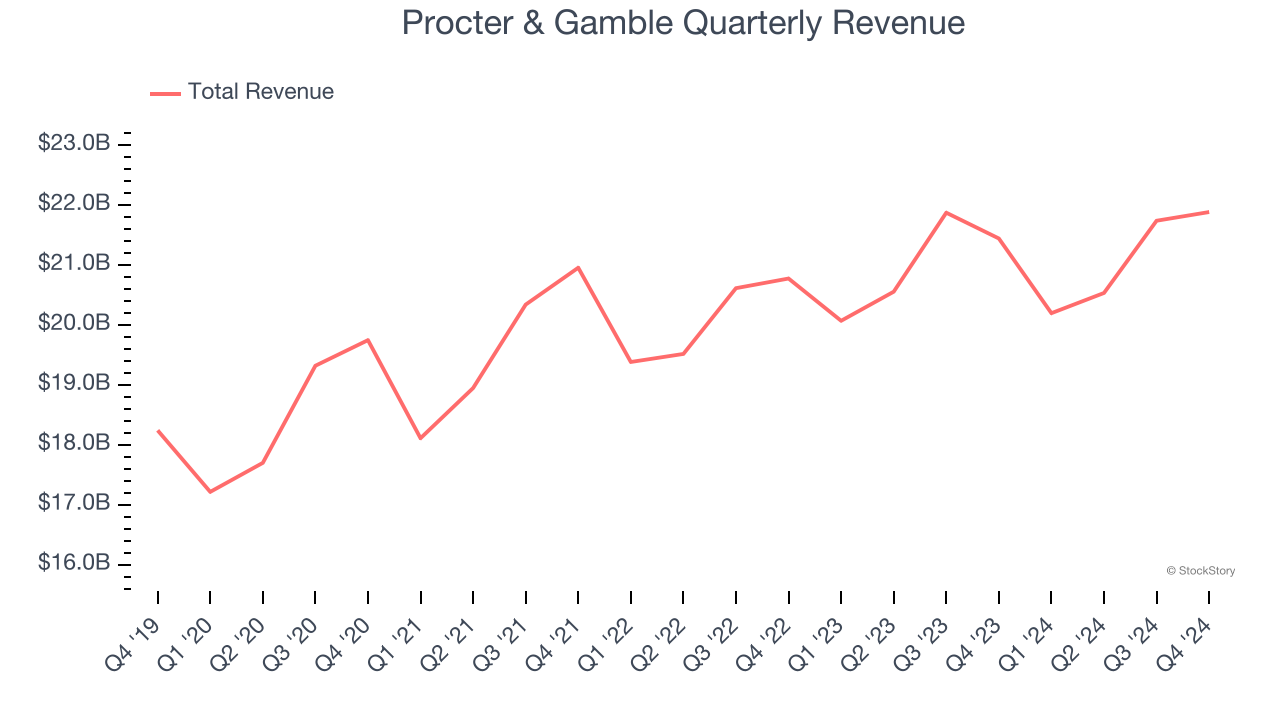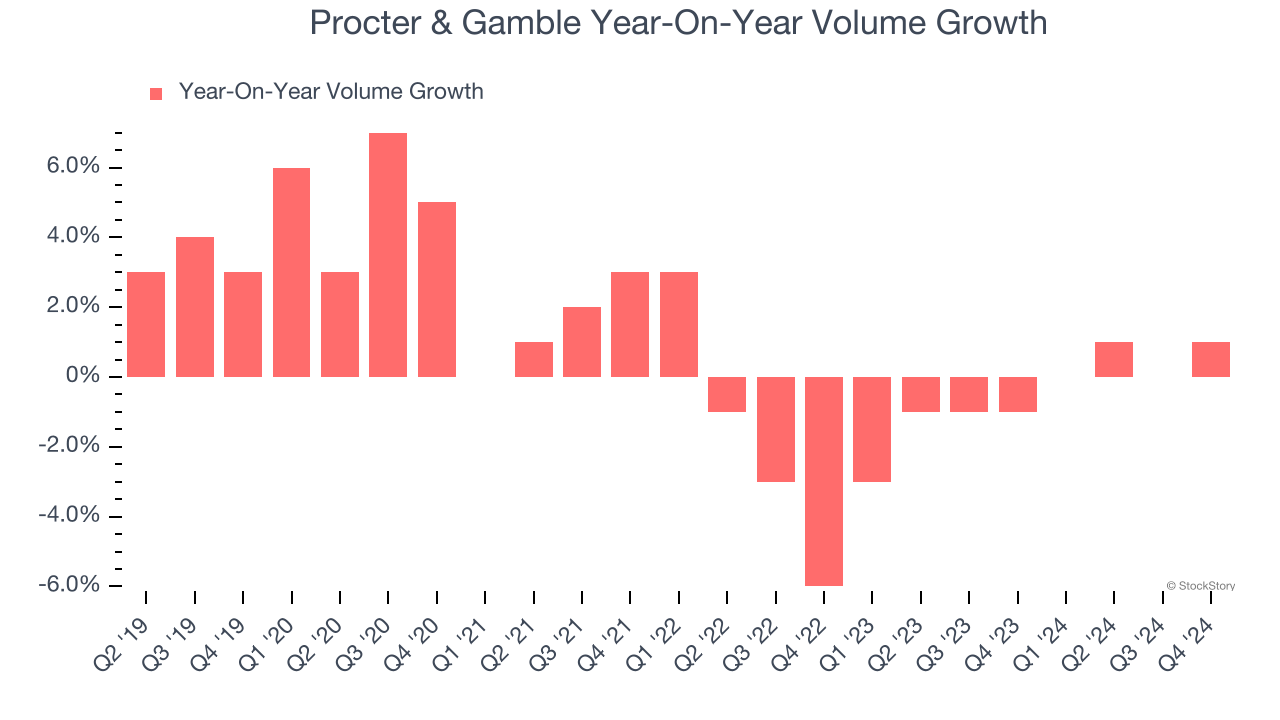Consumer products behemoth Proctor & Gamble (NYSE:PG) reported revenue ahead of Wall Street’s expectations in Q4 CY2024, with sales up 2.1% year on year to $21.88 billion. Its non-GAAP profit of $1.88 per share was 1.1% above analysts’ consensus estimates.
Is now the time to buy Procter & Gamble? Find out by accessing our full research report, it’s free.
Procter & Gamble (PG) Q4 CY2024 Highlights:
- Revenue: $21.88 billion vs analyst estimates of $21.59 billion (2.1% year-on-year growth, 1.3% beat)
- Adjusted EPS: $1.88 vs analyst estimates of $1.86 (1.1% beat)
- Adjusted EBITDA: $6.67 billion vs analyst estimates of $6.51 billion (30.5% margin, 2.3% beat)
- Management reiterated its full-year Adjusted EPS guidance of $6.98 at the midpoint
- Operating Margin: 26.2%, down from 27.4% in the same quarter last year
- Free Cash Flow Margin: 17.8%, down from 20% in the same quarter last year
- Organic Revenue rose 3% year on year (4% in the same quarter last year)
- Sales Volumes rose 1% year on year (-1% in the same quarter last year)
- Market Capitalization: $380.9 billion
“The P&G team delivered an acceleration in organic sales growth, core EPS growth and strong cash return to shareowners in the second quarter,” said Jon Moeller, Chairman of the Board, President and Chief Executive Officer.
Company Overview
Founded by candle maker William Procter and soap maker James Gamble, Proctor & Gamble (NYSE:PG) is a consumer products behemoth whose product portfolio spans everything from facial tissues to laundry detergent to feminine care to men’s grooming.
Household Products
Household products stocks are generally stable investments, as many of the industry's products are essential for a comfortable and functional living space. Recently, there's been a growing emphasis on eco-friendly and sustainable offerings, reflecting the evolving consumer preferences for environmentally conscious options. These trends can be double-edged swords that benefit companies who innovate quickly to take advantage of them and hurt companies that don't invest enough to meet consumers where they want to be with regards to trends.
Sales Growth
A company’s long-term sales performance can indicate its overall quality. Any business can put up a good quarter or two, but many enduring ones grow for years.
Procter & Gamble is one of the most widely recognized consumer staples companies. Its influence over consumers gives it negotiating leverage with distributors, enabling it to pick and choose where it sells its products (a luxury many don’t have). However, its scale is a double-edged sword because it's harder to find incremental growth when your existing brands have penetrated most of the market. To accelerate sales, Procter & Gamble must lean into newer products.
As you can see below, Procter & Gamble’s sales grew at a sluggish 2.5% compounded annual growth rate over the last three years as it failed to grow its volumes. We’ll explore what this means in the "Volume Growth" section.

This quarter, Procter & Gamble reported modest year-on-year revenue growth of 2.1% but beat Wall Street’s estimates by 1.3%.
Looking ahead, sell-side analysts expect revenue to grow 2.4% over the next 12 months, similar to its three-year rate. This projection is underwhelming and indicates its newer products will not lead to better top-line performance yet. At least the company is tracking well in other measures of financial health.
Today’s young investors won’t have read the timeless lessons in Gorilla Game: Picking Winners In High Technology because it was written more than 20 years ago when Microsoft and Apple were first establishing their supremacy. But if we apply the same principles, then enterprise software stocks leveraging their own generative AI capabilities may well be the Gorillas of the future. So, in that spirit, we are excited to present our Special Free Report on a profitable, fast-growing enterprise software stock that is already riding the automation wave and looking to catch the generative AI next.
Volume Growth
Revenue growth can be broken down into changes in price and volume (the number of units sold). While both are important, volume is the lifeblood of a successful staples business as there’s a ceiling to what consumers will pay for everyday goods; they can always trade down to non-branded products if the branded versions are too expensive.
To analyze whether Procter & Gamble generated its growth from changes in price or volume, we can compare its volume growth to its organic revenue growth, which excludes non-fundamental impacts on company financials like mergers and currency fluctuations.
Over the last two years, Procter & Gamble’s quarterly sales volumes have, on average, stayed about the same. This stability is normal as the quantity demanded for consumer staples products typically doesn’t see much volatility. The company’s flat volumes also indicate its average organic revenue growth of 4.5% was generated from price increases.

In Procter & Gamble’s Q4 2025, sales volumes jumped 1% year on year. This result was a well-appreciated turnaround from its historical levels, showing the company is heading in the right direction.
Key Takeaways from Procter & Gamble’s Q4 Results
It was encouraging to see Procter & Gamble beat analysts’ revenue and EPS expectations. That the company reiterated full-year EPS guidance is also comforting, showing that the business is firmly on track with no surprises. The stock traded up 2.6% to $165.86 immediately after reporting.
Big picture, is Procter & Gamble a buy here and now? When making that decision, it’s important to consider its valuation, business qualities, as well as what has happened in the latest quarter. We cover that in our actionable full research report which you can read here, it’s free.
